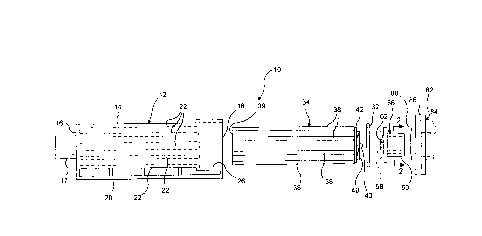Some of the information on this Web page has been provided by external sources. The Government of Canada is not responsible for the accuracy, reliability or currency of the information supplied by external sources. Users wishing to rely upon this information should consult directly with the source of the information. Content provided by external sources is not subject to official languages, privacy and accessibility requirements.
Any discrepancies in the text and image of the Claims and Abstract are due to differing posting times. Text of the Claims and Abstract are posted:
| (12) Patent: | (11) CA 2302847 |
|---|---|
| (54) English Title: | ONE-WAY HINGE DAMPER |
| (54) French Title: | AMORTISSEUR ARTICULE UNIDIRECTIONNEL |
| Status: | Expired and beyond the Period of Reversal |
| (51) International Patent Classification (IPC): |
|
|---|---|
| (72) Inventors : |
|
| (73) Owners : |
|
| (71) Applicants : |
|
| (74) Agent: | FINLAYSON & SINGLEHURST |
| (74) Associate agent: | |
| (45) Issued: | 2004-11-02 |
| (22) Filed Date: | 2000-03-28 |
| (41) Open to Public Inspection: | 2000-10-08 |
| Examination requested: | 2000-03-28 |
| Availability of licence: | N/A |
| Dedicated to the Public: | N/A |
| (25) Language of filing: | English |
| Patent Cooperation Treaty (PCT): | No |
|---|
| (30) Application Priority Data: | ||||||
|---|---|---|---|---|---|---|
|
The one-way hinge damper includes a cylindrical housing into
a rotor is rotatably inserted. A gap is formed between the rotor
and the cylindrical housing which is filled with silicone or a
similar viscous fluid for damping the rotation of the rotor. The
damping can be increased by forming longitudinal grooves or similar
discontinuities in the interior surface of the cylindrical housing
and longitudinal passageways on the exterior surface of the rotor.
A clutch, to which the output shaft is attached, is biased against
an end of the rotor by a wave spring. Both the clutch and the end
of the rotor include complementary rotationally alternating ramped
surfaces and flat (or longitudinally level) surfaces. Radially
extending walls are formed between the higher end of the ramped
surfaces and the adjacent flat surface. When the output shaft and
the clutch are rotated in a first direction, the radially extending
walls of the clutch align with and engage the radially extending
walls of the rotor and the rotor rotates through the viscous fluid
thereby achieving damping. However, when the output shaft and
clutch are rotated in a second direction, the ramped surfaces of
the clutch "ramp over" the ramped surfaces of the rotor, and the
rotor does not rotate, thereby allowing the clutch and output shaft
to rotate substantially free of damping.
Note: Claims are shown in the official language in which they were submitted.
Note: Descriptions are shown in the official language in which they were submitted.

2024-08-01:As part of the Next Generation Patents (NGP) transition, the Canadian Patents Database (CPD) now contains a more detailed Event History, which replicates the Event Log of our new back-office solution.
Please note that "Inactive:" events refers to events no longer in use in our new back-office solution.
For a clearer understanding of the status of the application/patent presented on this page, the site Disclaimer , as well as the definitions for Patent , Event History , Maintenance Fee and Payment History should be consulted.
| Description | Date |
|---|---|
| Inactive: IPC assigned | 2022-11-14 |
| Inactive: IPC expired | 2017-01-01 |
| Time Limit for Reversal Expired | 2007-03-28 |
| Letter Sent | 2006-03-28 |
| Inactive: IPC from MCD | 2006-03-12 |
| Inactive: IPC from MCD | 2006-03-12 |
| Inactive: IPC from MCD | 2006-03-12 |
| Inactive: IPC from MCD | 2006-03-12 |
| Grant by Issuance | 2004-11-02 |
| Inactive: Cover page published | 2004-11-01 |
| Pre-grant | 2004-08-19 |
| Inactive: Final fee received | 2004-08-19 |
| Notice of Allowance is Issued | 2004-03-01 |
| Notice of Allowance is Issued | 2004-03-01 |
| Letter Sent | 2004-03-01 |
| Inactive: Approved for allowance (AFA) | 2004-01-29 |
| Amendment Received - Voluntary Amendment | 2003-11-27 |
| Inactive: S.30(2) Rules - Examiner requisition | 2003-06-04 |
| Inactive: Cover page published | 2000-10-08 |
| Application Published (Open to Public Inspection) | 2000-10-08 |
| Inactive: First IPC assigned | 2000-06-08 |
| Inactive: IPC assigned | 2000-06-08 |
| Inactive: Filing certificate - RFE (English) | 2000-04-26 |
| Filing Requirements Determined Compliant | 2000-04-26 |
| Letter Sent | 2000-04-26 |
| Application Received - Regular National | 2000-04-26 |
| All Requirements for Examination Determined Compliant | 2000-03-28 |
| Request for Examination Requirements Determined Compliant | 2000-03-28 |
There is no abandonment history.
The last payment was received on 2004-03-15
Note : If the full payment has not been received on or before the date indicated, a further fee may be required which may be one of the following
Please refer to the CIPO Patent Fees web page to see all current fee amounts.
| Fee Type | Anniversary Year | Due Date | Paid Date |
|---|---|---|---|
| Application fee - standard | 2000-03-28 | ||
| Registration of a document | 2000-03-28 | ||
| Request for examination - standard | 2000-03-28 | ||
| MF (application, 2nd anniv.) - standard | 02 | 2002-03-28 | 2002-03-07 |
| MF (application, 3rd anniv.) - standard | 03 | 2003-03-28 | 2003-03-13 |
| MF (application, 4th anniv.) - standard | 04 | 2004-03-29 | 2004-03-15 |
| Final fee - standard | 2004-08-19 | ||
| MF (patent, 5th anniv.) - standard | 2005-03-29 | 2005-03-04 |
Note: Records showing the ownership history in alphabetical order.
| Current Owners on Record |
|---|
| ILLINOIS TOOL WORKS INC. |
| Past Owners on Record |
|---|
| STEVEN L. BIVENS |